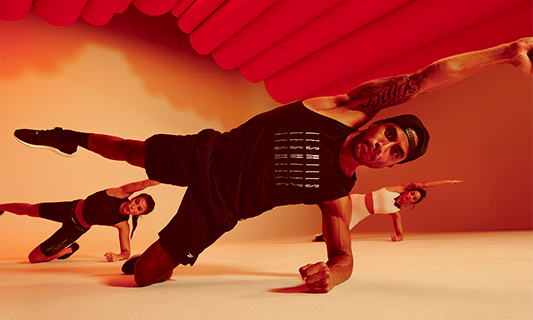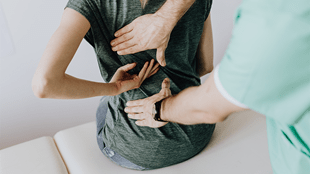Experts estimate that 80 percent of us will experience a back problem at some point in our lives. A whopping 540 million people are thought to be dealing with back pain right now. In the United States alone, back pain accounts for 2.6 million emergency visits each year, with almost $50bn spent annually on the issue. It’s also one of the most common reasons for missed work.
So what causes low back pain?
The prevalence of low back pain stems from our sedentary culture. Many of us spend most of our workday sitting, and then come home and sit in the evening. Even people who get the recommended amount of physical activity can also spend a lot of time being sedentary. As Bryce Hastings, Physiotherapist and Les Mills Head of Research, points out, an hour of exercise in the morning won’t mitigate the risk that comes from spending the next eight hours sitting at a computer screen. He explains that our spines collapse under very little pressure and they need an active support network to hold them up. “When we are sitting our postural muscles get weaker and are less able to support us when we need them to. If we stay in a slouched position for long periods our back muscles stretch. Prolonged stretching can prevent muscles from firing when you need them to, and that can lead to injury and pain.” says Hastings.
"Motion is lotion. Reducing sedentary time will help improve the endurance of the low back muscles.”
Kinesiology researcher, Dr. Gillian Hatfield says most low back pain can be pinned on low back muscle weakness. If a muscle has to work beyond its strength or endurance capacity then it can get injured. Where it gets complicated is the fact that it's such a broad anatomic area. “You're not dealing with just a single joint like the knee or the ankle, there are multiple joints in the low back, each having many ligaments and muscles. So one person’s low back injury likely won’t be the same as another person’s low back injury.” She says it’s often really difficult to pin down exactly what is causing a person’s pain, which is why you hear the term “non-specific low back pain”.
One of the biggest misconceptions is that you should rest if you’re suffering low back pain. This is not the case. While it might seem sensible to take a load off on the sofa, staying active is much more important. Hatfield doesn't advocate pushing on and training at your usual intensity but says any movement such as going for a walk is good, and often it ends up reducing pain. "I believe motion is lotion. Reducing sedentary time will help improve the endurance of the low back muscles, and the increased blood flow and exercise-induced endorphins will help reduce pain and stiffness.”

“Increased blood flow and exercise-induced endorphins will help reduce pain and stiffness.”
Yoga, walking, cycling are all great options. Hatfield advises you to use your pain level as your guide. “Pain shouldn’t increase during exercise and if it increases in the 24-48 hours post-exercise, then just back off the intensity and try again.”
Hastings suggests that in many cases, simply identifying how to stop hurting yourself can be the most effective treatment. He suggests you consider two scenarios:
Patient one goes to the doctor with a sore thumb. The doctor asks him when it hurts. He replies: “When I grab it with my other hand and pull it back as far as I can and hold it like that for a few hours.” The perplexed doctor tells him to stop doing that.
Patient two goes to the doctor with a sore back. The doctor asks him when it hurts. He replies with: "When I sit like this (slouching) at my desk for a few hours." The doctor prescribes anti-inflammatories, a chiropractor referral, and suggests an MRI if things don't improve.
Perhaps if patient two was given the same advice as patient one and simply stopped the action that was causing the pain they would be on a much easier journey to recovery.
Having spent many years treating patients as a physiotherapist, Hastings has some simple rules that will help you stay pain-free.
SIMPLE RULES TO EASE LOW BACK PAIN SUFFERING
Rule #1 Don’t slouch
Slouching turns your spinal muscles into jello, explains Hastings. If you have to sit for long periods (which is best avoided) you should sit with a slight inward curve in your lower back.
When we sit in a rounded posture for long periods we put stress on our discs. You've likely heard of a "slipped disc", but the reality is that discs don’t really slip – they ooze. Our discs are little gel-filled pads that sit between our vertebrae. The gel is usually contained in the center, with rings of connective tissue that keep it in place. Prolonged rounding of the lower back stretches and breaks down the connective tissue rings at the back of your spine. This means the gel part of the disc can leak backward, creating a bulge at the back of the disc.
As a result, your back can become sensitive when slouching, or even just bending forward to put your shoes on. If you ignore this and keep slouching, the disc can continue oozing to a point where it puts pressure on nerves that run through the back of your spine. This can really hurt and sometimes needs surgery.
However, if you recognize the issue early on it can be rectified – you just need to follow rule one and rule two.
Rule #2 If your back hurts bending – try extending
We often do this instinctively. If you've been bent over in the garden for prolonged periods when you come to stand up it's likely you'll instinctively bend backward. This helps balance out the pressure in your discs and may help recentralize the gel, preventing it from moving to the back of your spine.
A great way to get the benefits of extension is to lie on your stomach and gently push up through your arms to lift your chest while keeping your hips down. Hold for just a couple of seconds and go back down again – repeat 10 times and do this whenever you feel that discomfort from bending forward or slouched sitting.
This exercise should give you relief. If you encounter any increased pain as you perform multiple repetitions please have your back assessed to ensure this exercise is appropriate for you.

Rule #3 If your back feels unstable – stabilize it
Core-focused exercises such as hovers and planks are great options as they are geared toward keeping these muscles in your trunk strong and stable. Squats and deadlifts (even with just bodyweight) are also great stability exercises. Just remember to keep that slight inward curve in your lower back as you do them.
The golden rule: Get active
Workouts such as LES MILLS CORE™ can be a great way to alleviate the risks of back pain. Hatfield is currently leading a study investigating the effects of LES MILLS CORE in restoring muscle function after an episode of lower back pain – watch this space.
To read more insights from Bryce Hastings on the dangers of a sedentary lifestyle, check out the perils of sitting.
Bryce Hastings
A global expert in the science behind group fitness, Bryce Hastings has led ground-breaking research and collaborated with internationally-renowned research partners to unearth the latest and most effective fitness techniques. He has co-developed research programs on core conditioning, high-intensity interval training and exercise strategies for sedentary individuals, while also having a critical role in ensuring every LES MILLS™ program is safe, effective and grounded in science.
Dr. Gillian Hatfield
Dr. Gillian Hatfield is a biomechanics and athletic injuries teacher and researcher, with a background in physiotherapy. She specializes in biomechanics and muscle activation patterns, with a particular interest in the effect of exercise interventions on knee osteoarthritis or low back pain. In addition to being an Assistant Professor in Kinesiology at Canada's University of the Fraser Valley, Dr. Hatfield is also a certified Les Mills Instructor working with GoodLife Fitness.








